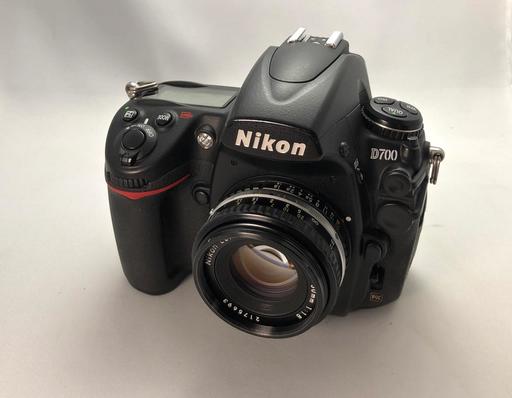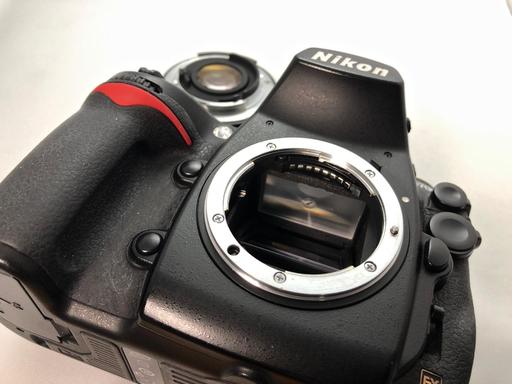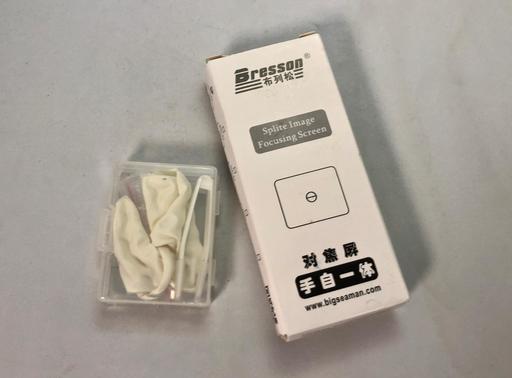I still mount manual focus Nikkors on my aging, but more than serviceable Nikon D700. I keep the DSLR in the studio for testing optics for TheFilmCameraShop (typically 35mm analog Nikons such as the wonderful FG) and for using on my mirrorless cameras as well.
 Nikon D700 with Series E 50mm f/1.8 manual focus lens. Photos by Derrick Story.
Nikon D700 with Series E 50mm f/1.8 manual focus lens. Photos by Derrick Story.
The only problem, as with practically every digital AF camera, is that the viewfinder screen isn't really designed for manually focusing lenses. Yes, we do have digital focus assist, which I like, but not those wonderful micro prism collars that I love.
So I decided to take a chance on replacing the factory screen with a 3rd party option that's better designed for older glass. (I bought my replacement from Terences Camera that has all sorts of screens and adapters for a variety of cameras.) This should have been a no-brainer for me. I change focusing screens all the time on 35mm film cameras, and I rarely screw things up. But for some reason, I was a bit more nervous about operating on a digital SLR, especially transplanting a $30 screen that was shipped directly from China.
I was, however, determined to attempt this procedure. So I found the installation instructions online and prepared for surgery.
The Double 45 Degree Split Image Focusing Screen that I bought from Terences Camera was nicely packed in its own little box with a microfiber cloth, padded tweezers, and little latex finger cots. (I think they were for Chinese fingers, however, because I could barely get the second one over my thumb.) I kept the Rocket Blaster handy in case I spotted any dust during the transplant.
 The new focusing screen installed in the D700.
The new focusing screen installed in the D700.
The original Nikon screen popped out easily once I found the spring latch. I removed it from the mirror box with the cute little padded tweezers (forceps?), and safely stored it, just in case I needed to return to factory settings someday in the future. I then inserted the split image screen, swung the hinged frame upward until I heard the secure click of the latch. "Close her up!" I proudly exclaimed to the surgical assistant as I pulled off my latex finger cots. (Actually, my cat was the only other living creature in the room at the time, and she just wanted her dinner.)
Now for the post-op test. I mounted a Nikon Series E 50mm f/1.8 and looked through the viewfinder. "Not bad," I thought. I focused without manual assist on subjects both near and far, then uploaded the RAW files to Capture One on my Mac for close examination. "These look quite good," I thought, sounding like a surgeon surveying X-rays on a light box.
The images were all crisp and focused just as I had intended. While shooting with the D700, I had used all the different focusing aids on the screen: diagonal split view, micro prism collar, and the matte surface. The results looked great.
The procedure was successful. Even though this wasn't a top of the line screen at a premium price, it was more than serviceable, and exactly what I had been looking for.
It's now even more enjoyable to use some of my favorite Nikon MF optics on the D700, such as the 105mm f/2.5. I have CPU data profiles set up for all the lenses, so the camera works great in Aperture Priority mode, and I get basic metadata as well.
I don't think I will convert my D610 because it's mostly an AF camera for me, and I would be even more nervous about the procedure. (BTW: the replacement screen does not compromise AF functionality, however.) But I will probably use the D700 more now thanks to the modification. The screen really does change things. It's like a cool hybrid shooter that focuses like a 35mm camera, but renders digital files.
All in all, a successful operation.
You can share your thoughts at the TDS Facebook page, where I'll post this story for discussion.












